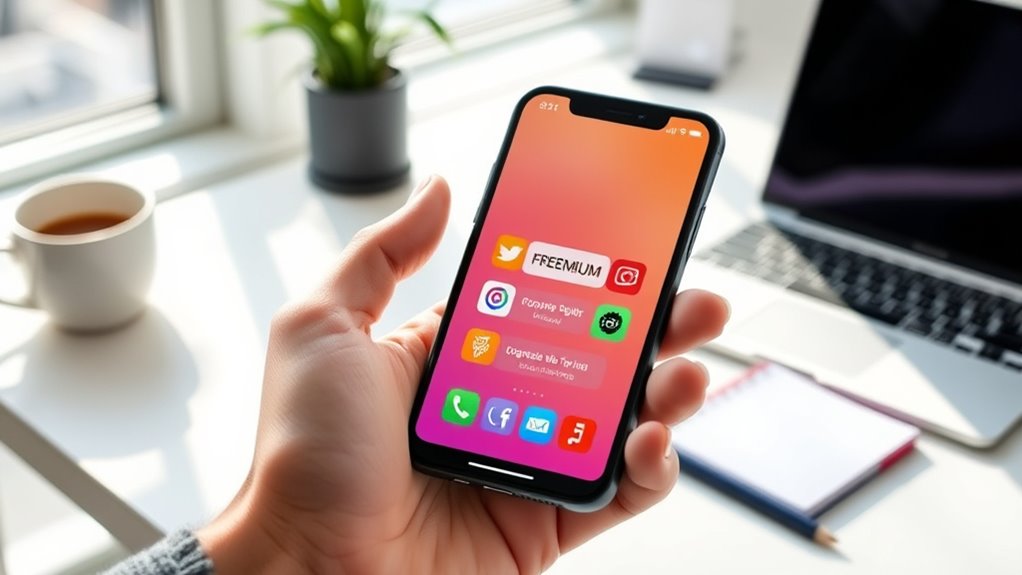To convert users without annoying them, focus on providing genuine value upfront by offering core features for free and showcasing the benefits clearly. Design your freemium model to feel natural and pressure-free, guiding users smoothly toward paid options through thoughtful prompts and regular updates. Keep the experience engaging and personalized, so users stay satisfied and curious about upgrades. If you want to discover more strategies, just stay tuned for expert insights.
Key Takeaways
- Offer valuable core features for free to build trust and demonstrate benefits upfront.
- Design upgrade prompts to be natural and non-intrusive, encouraging exploration without pressure.
- Personalize user experiences based on behavior to increase perceived value and relevance.
- Regularly update features and benefits to motivate voluntary upgrades and maintain engagement.
- Balance free functionality with appealing premium options, avoiding manipulative tactics to reduce frustration.

Have you ever wondered how many apps and online services offer free access while still generating revenue? It’s a clever balancing act, and it all comes down to effective freemium models. These models rely on strategic pricing strategies that attract users without overwhelming or annoying them. The key is giving enough value upfront to hook users and then offering premium features that feel like a genuine upgrade, not a sneaky upsell. When done right, this approach keeps user engagement high, encouraging people to stick around and explore more of what your platform has to offer.
Your goal with freemium is to create a seamless experience where users naturally want to pay for extra features. To do that, you need to carefully consider your pricing strategies. For example, you might offer core features for free but reserve advanced tools, customization options, or ad-free experiences for paying users. This way, users get a taste of what’s possible without feeling forced to fork over cash immediately. It’s about building trust and demonstrating value early on. When users see the benefits clearly, they’re more likely to convert to paying customers without feeling pressured or annoyed. The best freemium apps strike a delicate balance—enough free functionality to satisfy casual users, but tantalizing premium options that genuinely enhance their experience.
Creating a seamless freemium experience encourages users to upgrade naturally without pressure.
User engagement is also critical. You want your free users to become active, involved members of your community. That means designing your free tier to be fun, useful, and easy to navigate. When users enjoy their experience, they naturally want to come back and explore more features. Keep them engaged with thoughtful prompts, occasional nudges towards premium upgrades, and regular updates that add value. But be cautious not to overdo it—constant upselling can turn users off or make your platform feel spammy. Instead, focus on delivering consistent quality and benefits that foster loyalty. When users see ongoing improvements and personalized experiences, they’re more inclined to upgrade voluntarily. Additionally, understanding user preferences and behaviors helps tailor the experience, much like how seasonal variations in natural environments can enhance camping trips.
In essence, successful freemium models rely on smart pricing strategies that prioritize user engagement. You want to create an environment where free users are satisfied, intrigued, and motivated to pay for additional features without feeling manipulated. By giving enough value upfront, maintaining a user-centric approach, and carefully planning your upgrade paths, you can convert users smoothly—maximizing revenue while keeping their experience positive. Incorporating AI-driven analysis into your strategy can help identify the most effective ways to optimize your offerings and increase conversion rates. Additionally, leveraging user data responsibly allows for more personalized experiences that can boost trust and retention. When you strike this balance, your app or service won’t just be free; it’ll be indispensable for your users, turning casual visitors into loyal customers over time.
Frequently Asked Questions
How Do Freemium Models Impact User Trust Long-Term?
You might wonder how freemium models affect user trust long-term. When you focus on providing real value and avoid nagging prompts, you build user loyalty. By clearly communicating the perceived value of premium features and respecting user experience, you foster trust. This transparency encourages users to stay engaged and consider upgrading, ultimately strengthening your relationship and ensuring the model benefits both your business and your users over time.
What Industries Benefit Most From Freemium Strategies?
You see, industries like tech startups and digital media benefit most from freemium strategies because they thrive on rapid user growth, engagement, and flexibility. By offering free access, you attract diverse audiences, build trust, and encourage upgrades without pressure. These models foster loyalty, increase revenue, and create a seamless experience, making it easier to convert users over time. It’s a win-win that fuels innovation and sustained success in competitive markets.
How Can Companies Prevent User Frustration With Freemium Limits?
To prevent user frustration with freemium limits, you should find the right paywall balance by offering enough free features to keep users engaged while using strategic feature gating for premium content. Clearly communicate what’s free and what’s premium, and avoid overly strict restrictions. This way, users feel valued and motivated to upgrade without feeling inconvenienced or annoyed, ensuring a positive experience and increasing conversion chances.
Are Freemium Models Sustainable Without Alienating Free Users?
Like Robin Hood balancing scales, freemium models aim to sustain growth while keeping users engaged. You can’t ignore that sustainable monetization strategies depend on fostering user retention without alienating free users. By offering real value in both free and paid tiers, you build trust and loyalty. This approach guarantees the model remains viable long-term, respecting users’ experience while generating revenue, much like a well-meaning guardian of the digital domain.
What Metrics Best Measure Freemium Conversion Success?
You want to know the best metrics for measuring freemium conversion success. Focus on user engagement, tracking how often free users interact with your features, and monitor revenue growth from paid conversions. These metrics reveal how well your strategy turns free users into paying customers without alienating them. By analyzing engagement patterns and revenue trends, you can optimize your approach for sustainable growth and improved conversion rates.
Conclusion
Embracing a freemium model is like planting a seed—you nurture users with value, and eventually, they bloom into paying customers. By offering just enough free features, you guide them gently toward paid upgrades without making the path feel like a sales pitch. When done right, this approach becomes a delicate dance, turning casual users into loyal patrons while keeping their experience as smooth as silk. Ultimately, it’s about building trust, not just transactions.










